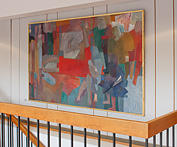Death of a Norse God
The gods’ favorite is killed. Balder, son of Odin, was so beloved for his beauty and goodness that his mother, Frigg, got every living and dead thing in the world to solemnly promise that he would not be harmed. She left out only one small, modest plant: the mistletoe. The cunning Loki was jealous of Balder, and convinced Balder’s blind brother to shoot Balder with the plant, in order to honor him. The mistletoe struck its mark, and Balder died.

Main content
Balders død (Balder’s death) in Else Christie Kielland’s version is similar to many early representations of Christ, where the god is shown outstretched, surrounded by grieving people. The mistletoe is just visible in the hand of the person beside Balder’s head. Human figures fill most of the surface, some of them almost blend into the background. The picture is divided into fields of different colors, giving it a geometric feel. The perspective comes off as distorted, strange, but it is rather unfolded - it's almost as if we are seeing the scene from multiple angles at once.
The picture is the middle of three paintings by Kielland with Norse motifs that are conceived as a triptych - a common model for altarpieces. This large middle section is brighter and darker in color than the other two paintings, which are more pastel-like, with a predominant pink tinge. In Balder’s death, red is the prominent specter. This image is also more geometrically abstracted than the two side sections, perhaps because it was painted later.
Else Christie Kielland (1903-1993) was a Bergen-born artist, writer and art theorist. She is best known for her landscape paintings from the West Coast of Norway, and for her portraits. Like Georg Jacobsen, Christie Kielland was very interested in geometric shapes, composition and the flat character of the painting. She wrote a book on stave churches and boats of the Viking age, analyzing them in comparison to Greek and Egyptian construction methods, which she was also very interested in. Like many of her contemporaries, she tried to discover the “eternal laws of art”, which she claimed to find in geometry. Great art could only be made “within the frameworks of the law”, she claimed.
NORA SØRENSEN VAAGE
